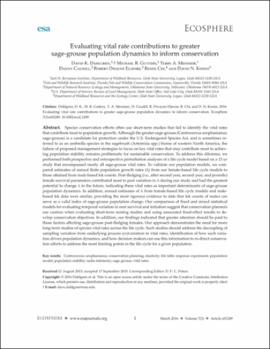| dc.contributor.author | Dahlgren, David K. | |
| dc.contributor.author | Guttery, Michael R. | |
| dc.contributor.author | Messmer, Terry A. | |
| dc.contributor.author | Caudill, Danny | |
| dc.contributor.author | Elmore, R. Dwayne | |
| dc.contributor.author | Chi, Renee | |
| dc.contributor.author | Koons, David N. | |
| dc.contributor.author | Peters, D. P. C. | |
| dc.date.accessioned | 2019-08-22T17:50:45Z | |
| dc.date.available | 2019-08-22T17:50:45Z | |
| dc.date.issued | 2016-03 | |
| dc.identifier | oksd_dahlgren_evaluatingvital_2016 | |
| dc.identifier.citation | Dahlgren, D. K., Guttery, M. R., Messmer, T. A., Caudill, D., Elmore, R. D., Chi, R., & Koons, D. N. (2016). Evaluating vital rate contributions to greater sage-grouse population dynamics to inform conservation. Ecosphere, 7(3). https://doi.org/10.1002/ecs2.1249 | |
| dc.identifier.uri | https://hdl.handle.net/11244/321225 | |
| dc.description.abstract | Species conservation efforts often use short‐term studies that fail to identify the vital rates that contribute most to population growth. Although the greater sage‐grouse (Centrocercus urophasianus; sage‐grouse) is a candidate for protection under the U.S. Endangered Species Act, and is sometimes referred to as an umbrella species in the sagebrush (Artemisia spp.) biome of western North America, the failure of proposed management strategies to focus on key vital rates that may contribute most to achieving population stability remains problematic for sustainable conservation. To address this dilemma, we performed both prospective and retrospective perturbation analyses of a life cycle model based on a 12‐yr study that encompassed nearly all sage‐grouse vital rates. To validate our population models, we compared estimates of annual finite population growth rates (λ) from our female‐based life cycle models to those attained from male‐based lek counts. Post‐fledging (i.e., after second year, second year, and juvenile) female survival parameters contributed most to past variation in λ during our study and had the greatest potential to change λ in the future, indicating these vital rates as important determinants of sage‐grouse population dynamics. In addition, annual estimates of λ from female‐based life cycle models and male‐based lek data were similar, providing the most rigorous evidence to date that lek counts of males can serve as a valid index of sage‐grouse population change. Our comparison of fixed and mixed statistical models for evaluating temporal variation in nest survival and initiation suggest that conservation planners use caution when evaluating short‐term nesting studies and using associated fixed‐effect results to develop conservation objectives. In addition, our findings indicated that greater attention should be paid to those factors affecting sage‐grouse post‐fledging females. Our approach demonstrates the need for more long‐term studies of species vital rates across the life cycle. Such studies should address the decoupling of sampling variation from underlying process (co)variation in vital rates, identification of how such variation drives population dynamics, and how decision makers can use this information to re‐direct conservation efforts to address the most limiting points in the life cycle for a given population. | |
| dc.format | application/pdf | |
| dc.language | en_US | |
| dc.publisher | Ecological Society of America | |
| dc.rights | This material has been previously published. In the Oklahoma State University Library's institutional repository this version is made available through the open access principles and the terms of agreement/consent between the author(s) and the publisher. The permission policy on the use, reproduction or distribution of the material falls under fair use for educational, scholarship, and research purposes. Contact Digital Resources and Discovery Services at lib-dls@okstate.edu or 405-744-9161 for further information. | |
| dc.title | Evaluating vital rate contributions to greater sage-grouse population dynamics to inform conservation | |
| osu.filename | oksd_dahlgren_evaluatingvital_2016.pdf | |
| dc.description.peerreview | Peer reviewed | |
| dc.identifier.doi | 10.1002/ecs2.1249 | |
| dc.description.department | Natural Resource Ecology and Management | |
| dc.type.genre | Article | |
| dc.type.material | Text | |
| dc.subject.keywords | centrocercus urophasianus | |
| dc.subject.keywords | conservation planning | |
| dc.subject.keywords | elasticity | |
| dc.subject.keywords | life table response experiment | |
| dc.subject.keywords | population model | |
| dc.subject.keywords | population stability | |
| dc.subject.keywords | radio-telemetry | |
| dc.subject.keywords | sage-grouse | |
| dc.subject.keywords | vital rates | |
